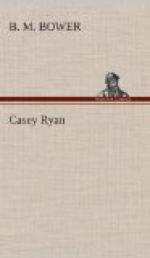Even the water tank is a disappointment to the uninitiated. You cannot drink the water which the pump draws wheezingly up from some deep reservoir of bad flavors. It is very clear water and it has a sparkle that lures the unwary, but it is common knowledge that no man ever drank two swallows of it if he could help himself. So the water supply of Patmos lies twelve miles away in the edge of the hills, where there is a very good spring. One of the six male residents of Patmos hauls water in barrels, at fifty cents a barrel. He makes a living at it, too.
One other male resident keeps the lodging place,—I avoid the term lodging house, because this place is not a house. It is a shack with a sign straddling out over the hot porch to insult the credulity of the passers-by. The sign says that this place is “The Oasis,”—and the nearest trees a long rifleshot away, and the coolest water going warm into parched mouths!
The Oasis stands over by the highway, alongside Casey’s garage, and the proprietor spends nine tenths of his waking hours sitting on the front porch and following the strip of shade from the west end to the east end, and in watching the trains go by, and counting the cars of tourists and remarking upon the State license plate.
“There’s an outfit from Ioway, maw,” he will call in to his wife. “Wonder where they’re headed fer?” His wife will come to the door and look apathetically at the receding dust cloud, and go back somewhere,—perhaps to put fresh soap in the tents to melt. Toward evening the cars are very likely to slow down and stop reluctantly; sunburned, goggled women and men looking the place over without enthusiasm. It isn’t much of a place, to be sure, but any place is better than none in the desert, unless you have your own bed and frying pan with you, roped in dusty canvas to the back of your car.
Alongside the Oasis stands the garage, and in the garage swelters Casey,— during this episode. Just at first Bill came down from Lund and helped him to arrange and mark prices on his stock of tires and “parts” and accessories, and to remember the catalogue names for things so that he would recognize them when a car owner asked for them.
Casey, I must explain, had evolved a system of his own while driving his Ford wickedly here and there to the consternation of his fellow men. Whatever was not a hootin’-annie was a dingbat, and treated accordingly. The hootin’-annie appeared to be the thing that went wrong, while the dingbat was the thing the hootin’-annie was attached to. It was perfectly simple, to Casey and his Ford, but Bill thought it was a trifle limited and was apt to confuse customers. So Bill remained three days mopping his face with his handkerchief and explaining things to Casey. After that Casey hired a heavy-eyed young Mexican to pump tires and fill radiators and the like, and settled down to make his fortune.




